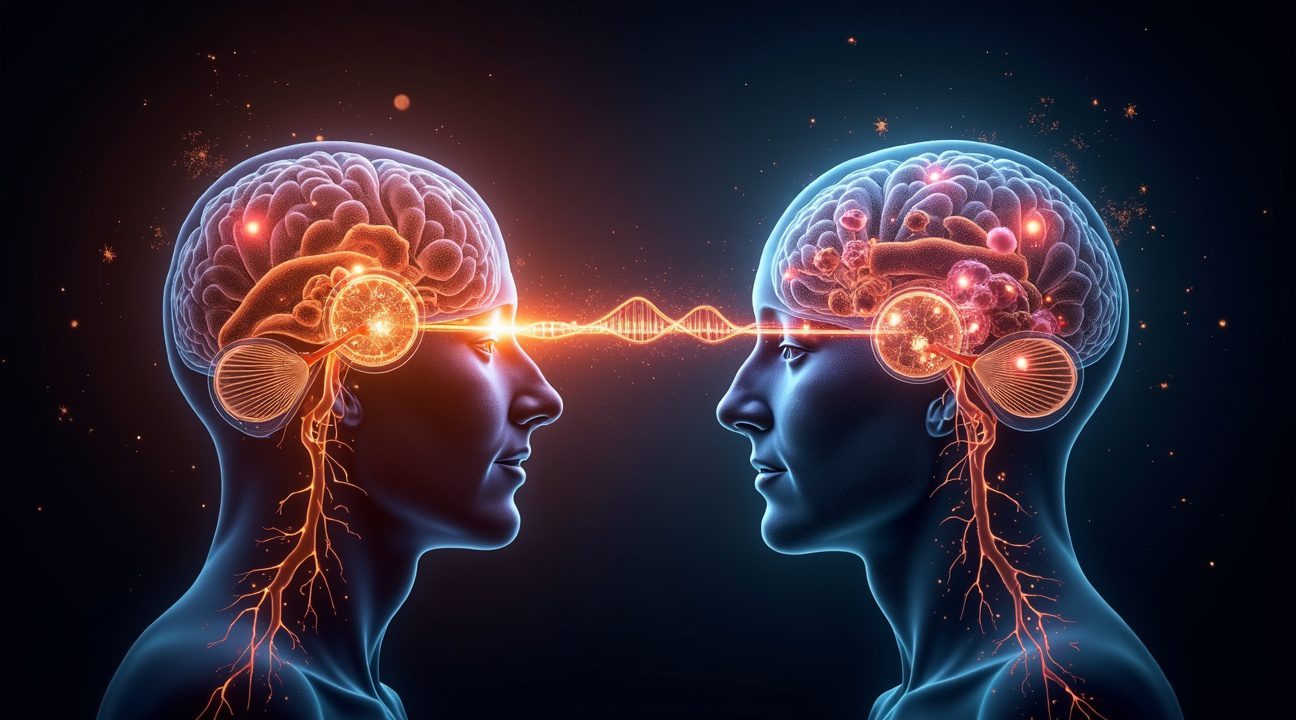During periods of hunger, the body activates autophagy, a sophisticated cellular recycling system that systematically breaks down and eliminates damaged, aging, or dysfunctional cellular components to maintain optimal function and promote longevity.
This remarkable survival mechanism transforms cells into efficient recycling centers that provide energy during food scarcity and serve as a powerful protective mechanism against various diseases associated with cellular dysfunction.
Key Takeaways
- Autophagy activation begins after 16–24 hours of fasting, with peak efficiency occurring around 36–72 hours. Even shorter intermittent fasting periods of 16–18 hours can trigger measurable cellular cleanup benefits.
- The process provides dual benefits by breaking down damaged proteins, worn-out organelles, and cellular waste, while simultaneously repurposing these components into energy or building blocks for new, healthy cellular structures.
- Recent research reveals brain protection capabilities, with studies showing that short-term fasting induces significant autophagy in crucial brain cells, offering substantial neuroprotection against age-related decline and neurodegeneration.
- Multiple practical methods can trigger autophagy, including intermittent fasting protocols like the 16/8 method, ketogenic dieting, high-intensity interval training, and calorie restriction of 20–30% below normal intake.
- Medical supervision is essential for extended fasting, as prolonged periods without food can cause nutrient deficiencies, muscle loss, and hormonal imbalances—particularly dangerous for pregnant women, those with eating disorders, or individuals taking medications.
Your Body’s Hidden Survival Mechanism: Cellular Self-Cleaning During Hunger
When hunger strikes, your body activates an extraordinary survival mechanism that goes far beyond simply burning stored fat for energy. This remarkable process, known as autophagy, transforms your cells into efficient recycling centers that systematically break down and eliminate damaged, aging, or dysfunctional cellular components. The term autophagy literally translates to “self-eating,” which perfectly describes how your cells cannibalize their own defective parts to maintain optimal function and promote longevity.
I find it fascinating how this cellular recycling system operates with precision during periods of fasting or calorie restriction. Your cells begin to disassemble misfolded proteins that could otherwise accumulate and cause cellular dysfunction. These damaged proteins, along with worn-out organelles like mitochondria through a specialized process called mitophagy, get broken down into their basic components. The cellular cleanup doesn’t stop there – your body then repurposes these useful molecules for energy production or uses them as building blocks to construct new, healthy cellular structures.
How This Cellular Self-Cleaning Process Works
This cellular maintenance system functions as your body’s internal quality control department, constantly monitoring and removing components that no longer serve their purpose effectively. During periods of nutritional stress, autophagy ramps up significantly, allowing your cells to become more efficient at identifying and eliminating cellular debris. The process involves several key mechanisms that work together to ensure optimal cellular health:
- Damaged organelles get tagged for removal and transported to specialized cellular compartments for breakdown
- Misfolded proteins that could form dangerous aggregates are identified and processed before they cause harm
- Cellular waste products accumulate less frequently, reducing oxidative stress and inflammation
- Essential nutrients get recycled from broken-down components, providing energy during food scarcity
- Cell renewal accelerates as space becomes available for new, functional cellular structures
This cellular recycling process serves as a powerful protective mechanism against various diseases associated with cellular dysfunction. When your body eliminates sick and aging cells through autophagy, it effectively reduces the risk of cellular damage that could lead to serious health complications. The system helps maintain cellular integrity by preventing the accumulation of toxic proteins and damaged organelles that might otherwise compromise cell function.
Research has shown that autophagy plays a crucial role in protecting against cellular stress and maintaining overall health. This process becomes particularly important as we age, since our cells naturally accumulate more damage over time. By regularly engaging this self-cleaning mechanism through controlled fasting periods, your body can maintain better cellular health and potentially slow down age-related cellular decline.
The beauty of autophagy lies in its efficiency and sustainability. Unlike external interventions that might stress your system, this natural process works harmoniously with your body’s existing mechanisms. Your cells essentially become self-sufficient recycling facilities, breaking down what they no longer need while simultaneously creating what they require for optimal function.
Understanding this cellular self-eating process helps explain why periodic fasting has gained recognition as a powerful tool for promoting health and longevity. When you allow your body to enter this state of controlled nutritional stress, you’re essentially giving your cells permission to engage in deep cleaning and renewal. The damaged cells get eliminated, aging cells undergo repair, and your entire cellular network becomes more resilient and efficient.
This cellular cleanup system represents one of your body’s most sophisticated survival mechanisms, demonstrating how periods of hunger can actually strengthen your cellular foundation rather than simply depleting your energy stores. Just as Christopher Nolan’s films reveal hidden layers of complexity, autophagy unveils the intricate ways your body maintains itself at the cellular level during challenging times.
The Timeline: How Fasting Triggers Your Body’s Cleanup Crew
When I look at the science behind fasting and autophagy, I see a precisely orchestrated biological response that begins the moment food becomes scarce. Fasting and calorie restriction stand among the most powerful triggers for autophagy activation in the human body. The process starts when cells detect nutrient deprivation, particularly the absence of glucose, forcing a transition to internal energy reserves.
The Gradual Awakening of Cellular Cleanup
I’ve learned that autophagy doesn’t activate like a light switch being flipped on. Instead, it functions more like a dimmer switch, gradually increasing in intensity as fasting continues. Research shows that noticeable autophagy activity typically begins after 16–24 hours of fasting, with peak efficiency occurring around 36–72 hours. This timing explains why many people experience the most dramatic benefits during extended fasting periods.
Short-term fasting protocols can still deliver meaningful results. Even intermittent fasting approaches lasting 16–18 hours show increased autophagy markers in studies. Popular methods include:
- 16/8 protocol: eating within an 8-hour window daily
- 5:2 approach: eating normally five days a week, restricting calories for two
These accessible fasting strategies make autophagy activation practical for most people without requiring extreme measures.
Metabolic Switching and Enhanced Cleanup
The magic happens during metabolic switching, when the body shifts from carbohydrate metabolism to fat metabolism. This transition produces ketones, which not only serve as an alternative fuel source but actually enhance the autophagy process itself. I find it fascinating that this metabolic flexibility represents millions of years of evolutionary adaptation.
Long-term calorie restriction offers another pathway to autophagy activation. Studies demonstrate that reducing daily caloric intake by 10–40% below normal needs can slowly upregulate autophagy processes. This approach requires patience, as the benefits accumulate gradually over weeks and months rather than days.
The ketosis state that develops during extended fasting creates an optimal environment for cellular cleanup. Ketones appear to signal cells that resources are limited, prompting them to become more efficient by recycling damaged components. This dual benefit of alternative fuel production and enhanced autophagy makes fasting particularly effective for triggering the body’s internal cleanup crew.
Scientific Proof: How Cellular Cleanup Extends Life and Protects Your Brain
Research demonstrates that autophagy serves as the body’s internal recycling system, systematically removing damaged and aging cells to maintain tissue health. This cellular cleanup process directly contributes to increased longevity and significantly reduces disease risk in both animal models and human subjects.
Extending Lifespan Through Cellular Renewal
Scientists have documented how calorie restriction and intermittent fasting activate specific genes related to autophagy, leading to extended lifespan in laboratory animals. The process works by targeting damaged mitochondria and clearing cellular waste that would otherwise accumulate and contribute to aging. In human studies, participants who maintained fasting periods of 17–19 hours daily over one month showed measurable increases in autophagy signaling pathways.
I find it particularly fascinating that NASA scientists find essential discoveries extending beyond Earth, while we’re uncovering equally remarkable mechanisms within our own bodies. This cellular cleansing supports tissue and cell renewal, potentially slowing the aging process and reducing risks associated with both metabolic and neurodegenerative diseases.
Brain Protection Through Neuronal Autophagy
Recent breakthrough studies have overturned previous scientific beliefs about autophagy’s limitations. Researchers previously thought this cellular cleanup was restricted primarily to liver function. However, new evidence reveals that short-term fasting induces significant autophagy in crucial brain cells, including Purkinje neurons and cortical neurons.
Animal studies show dramatic increases in neuronal autophagy during brief fasting periods, offering substantial neuroprotection against age-related decline. This discovery has profound implications for preventing neurodegeneration and reducing inflammation in brain tissue. The brain’s ability to activate its own cleanup crew during periods of nutrient scarcity provides a natural defense mechanism against conditions that typically accompany aging.
The scientific evidence supports autophagy as a fundamental process for healthy aging and disease prevention. By systematically removing cellular debris and dysfunctional components, this biological mechanism helps maintain optimal brain function while supporting overall longevity. The research suggests that strategic fasting periods can harness this natural process to promote both physical and cognitive health throughout the aging process.

Practical Methods to Activate Your Body’s Self-Repair System
Several proven strategies can trigger the body’s natural autophagy process, allowing cells to clean house and remove damaged components. These methods range from dietary adjustments to exercise protocols that work synergistically to enhance cellular renewal.
Primary Dietary Approaches for Cellular Cleanup
The most effective dietary strategies center around intermittent fasting and calorie restriction. These approaches create the metabolic conditions necessary for cells to initiate their self-cleaning mechanisms.
Popular intermittent fasting methods include:
- The 16/8 method: Fast for 16 hours and eat within an 8-hour window daily
- Eat-Stop-Eat: Complete 24-hour fasts once or twice weekly
- The 5:2 diet: Restrict calories to 500-600 on two non-consecutive days each week
Extended fasting periods beyond 24 hours can provide even more powerful autophagy activation, though beginners should start with shorter windows and gradually increase duration. I recommend consulting healthcare providers before attempting longer fasting protocols.
The ketogenic diet offers an alternative path to cellular cleanup without traditional fasting. This high-fat, very low-carbohydrate regimen mimics fasting’s metabolic effects by inducing ketosis. A typical ketogenic diet consists of approximately 75% calories from fat and only 5-10% from carbohydrates. This macronutrient profile shifts the body into a fat-burning state that naturally promotes autophagy even while consuming food.
Exercise serves as another powerful autophagy promoter, particularly high-intensity interval training (HIIT). This form of physical activity activates cellular cleanup mechanisms in muscle and metabolic tissues. HIIT sessions create controlled stress that signals cells to remove damaged components and strengthen healthy structures.
Combining physical activity with fasting protocols can amplify autophagy benefits. Working out during fasted states may enhance the cellular cleanup process, though individuals should monitor their energy levels and adjust accordingly. Light to moderate exercise often works best during extended fasting periods.
Calorie restriction, even without complete fasting, can stimulate autophagy pathways. Reducing daily caloric intake by 20-30% while maintaining proper nutrition creates the metabolic environment necessary for enhanced cellular maintenance.
Temperature stress through cold exposure or heat therapy may also support autophagy activation. Cold showers, ice baths, or sauna sessions create beneficial stress that encourages cellular adaptation and cleanup processes.
Sleep quality plays a crucial role in autophagy regulation. The body naturally increases cellular cleanup during deep sleep phases, making consistent, quality rest essential for optimal cellular maintenance. I prioritize 7-9 hours of sleep nightly to support these natural repair cycles.
Certain compounds found in foods may support autophagy pathways. Green tea contains catechins that may enhance cellular cleanup, while resveratrol from red wine and berries shows promise in laboratory studies. However, dietary changes and fasting remain the most reliable methods for activating these processes.
Stress management becomes particularly important when implementing autophagy-promoting strategies. Chronic stress can interfere with cellular repair mechanisms, potentially counteracting the benefits of fasting or dietary changes. Meditation, yoga, or other relaxation techniques can support the body’s natural cleanup processes.
Hydration requirements may change during fasting periods. Maintaining adequate water intake supports cellular function and helps the body eliminate waste products generated during autophagy. Electrolyte balance also becomes crucial during extended fasting or ketogenic dieting.
Starting gradually with any autophagy-promoting strategy allows the body to adapt safely. Beginning with shorter fasting windows or gentle exercise routines helps establish sustainable practices that can be maintained long-term.
Individual responses to these interventions vary significantly. Some people adapt quickly to intermittent fasting, while others may find the ketogenic diet more suitable for their lifestyle and metabolism. Experimenting with different approaches helps identify the most effective and sustainable methods for each person’s unique situation.

Safety First: Understanding the Risks of Cellular Self-Cleaning
While autophagy offers compelling health benefits, I must emphasize that extended fasting carries real risks that require careful consideration. Extended periods without food can trigger nutrient deficiencies that compromise your immune system and overall well-being. Your body needs consistent access to essential vitamins, minerals, and amino acids to function properly, and prolonged restriction can create dangerous gaps in these requirements.
Muscle loss represents another significant concern with unsupervised fasting practices. When your body runs out of readily available glucose and stored glycogen, it may begin breaking down muscle tissue for energy instead of focusing solely on damaged cellular components. This process can weaken your physical strength and slow your metabolism, creating long-term health complications that far outweigh any potential benefits from cellular cleanup.
Critical Health Considerations for Safe Practice
Hormonal imbalances pose serious threats to your endocrine system during extended fasting periods. Your cortisol levels may spike while insulin sensitivity changes dramatically, potentially disrupting sleep patterns, mood regulation, and reproductive function. These hormonal shifts can be particularly dangerous for individuals with diabetes, thyroid disorders, or blood pressure conditions.
Medical supervision becomes absolutely essential when considering any fasting approach longer than 24 hours. Healthcare providers can monitor your vital signs, blood chemistry, and overall response to ensure your safety throughout the process. They’ll also help you understand how fasting might interact with any medications you’re currently taking, particularly those for blood sugar control or cardiovascular health.
I strongly recommend starting with shorter intermittent fasting windows before attempting longer periods:
- Begin with 12-16 hour fasting windows
- Gradually extend the duration only if your body responds well
This gradual approach allows your system to adapt while minimizing the shock to your metabolism and hormone production.
Proper hydration remains critical throughout any fasting period, as dehydration can quickly compound other health risks. Your kidneys work harder during fasting states, and maintaining adequate fluid intake supports the elimination of metabolic waste products your body generates during cellular breakdown.
Several populations should avoid extended fasting entirely without professional medical guidance:
- Pregnant women
- Individuals with eating disorder histories
- Those taking insulin or blood pressure medications
- People with chronic health conditions
These groups face heightened risks that make unsupervised fasting potentially dangerous.
I can’t stress enough the importance of listening to your body’s signals during any fasting practice. Dizziness, severe fatigue, irregular heartbeat, or persistent nausea indicate you should break your fast immediately and consult with a healthcare provider. Even though scientific research continues advancing our understanding of cellular processes, individual responses to fasting vary dramatically, making personalized medical guidance invaluable for safe implementation.

Sources:
Cleveland Clinic – “Autophagy: Definition, Process, Fasting & Signs”
National Library of Medicine (PMC) – “The Beneficial and Adverse Effects of Autophagic Response to Non-Pharmacological Interventions”
Institut Pasteur – “Intermittent fasting: cellular cleansing to improve health?”
Zerolongevity – “Autophagy Fasting: How to Do It + Why You Should”
Healthline – “Autophagy: Definition, Diet, Fasting, Cancer, Benefits, and More”
National Library of Medicine (PMC) – “Short-term fasting induces profound neuronal autophagy”
InsideTracker – “Autophagy Fasting: What You Should Know Before Starting”
Harrison Healthcare – “What is Autophagy? The Process, Causes and Signs”


